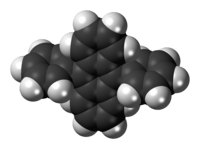9,10-Diphenylanthracene
From Wikipedia, the free encyclopedia
| 9,10-Diphenylanthracene | |
|---|---|
 | |
 | |
| 9,10-Diphenylanthracene | |
| Identifiers | |
| Abbreviations | DPA |
| CAS number | 1499-10-1 |
| ChemSpider | 14430 |
| Jmol-3D images | Image 1 Image 2 |
| |
| |
| Properties | |
| Molecular formula | C26H18 |
| Molar mass | 330.42 |
| Appearance | Yellow powder |
| Density | 1.22 g/cm3[1] |
| Melting point | 248 to 250 °C; 478 to 482 °F; 521 to 523 K |
| Except where noted otherwise, data are given for materials in their standard state (at 25 °C (77 °F), 100 kPa) | |
| Infobox references | |
9,10-Diphenylanthracene is a polycyclic aromatic hydrocarbon. It has the appearance of a slightly yellow powder. 9,10-Diphenylanthracene is used as a sensitiser in chemiluminescence. In lightsticks it is used to produce blue light. It is a molecular organic semiconductor, used in blue OLEDs and OLED-based displays.
See also
- 2-Chloro-9,10-diphenylanthracene, a chlorinated derivative
References
- ↑ Adams, J. M.; Ramdas, S. (1979). "The Crystal Structure of Solution-Grown 9,10-Diphenylanthracene. A Combined Computational and X-Ray Study". Acta Crystallographica Section B 35 (3): 679–683.
External links
This article is issued from Wikipedia. The text is available under the Creative Commons Attribution/Share Alike; additional terms may apply for the media files.